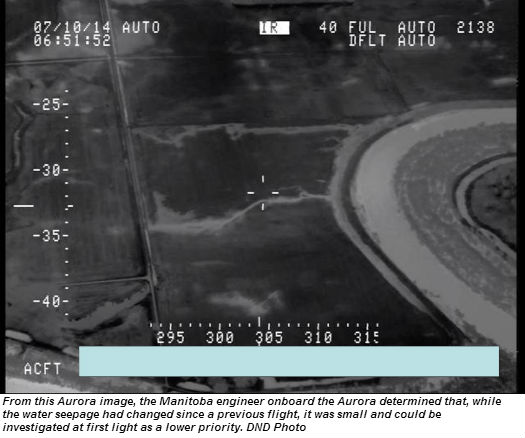RCAF Press Release | July 28, 2014
Estimated reading time 5 minutes, 3 seconds.
With relentless heavy rain through July, water levels in southern Manitoba began to rise along the Assiniboine River between Brandon, Portage La Prairie and Winnipeg.
With flooding to dangerous levels, the provincial government declared a state of emergency and requested military assistance to help protect property, agricultural land and individuals living in the areas affected.
As part of the military response, 1 Canadian Air Division – which has its headquarters in Winnipeg – directed 14 Wing Greenwood, Nova Scotia, to provide a CP-140 Aurora long-range patrol aircraft to supply surveillance support. The Aurora deployed on July 7, 2014, with a crew, maintenance support and a specialist operational support team to operate a ground station in the civil/ military unified command centre.
When it landed in Winnipeg, the Aurora needed to have an engine change due to a technical problem Moving swiftly, 1 Canadian Air Division directed 19 Wing Comox, British Columbia, to provide an additional aircraft for the first planned mission on July 8.
Staff from Manitoba’s Department of Infrastructure and Transport briefed the Aurora crews on the state of the levee system and headquarters staff brought them up to date on the mission’s requirements. The main need was to monitor the levee system and provide notification of any structure failures that would endanger lives and property along the river.
The river was expected to crest July 9 or 10, and then again July 15 or 16. The levees that run along the Assiniboine River are, in some places, more than 7.6 metres high and river levels were already running at maximum volume. Manitoba officials had already used the 24-kilometre-long, man-made relief channel known as the Diversion, which runs from Portage to Lake Manitoba. Engineering specialists warned that if any part of these structures failed, water could flow some 24 to 32 kilometres from the river.
Military personnel deployed along the river during the day to assist with sandbagging operations and flood preparation. The Aurora was used at night, putting its electro-optical and infra-red camera system and its overland mission system to good use. The aircraft’s speed allowed crew to complete a detailed assessment of the river and the Diversion every 30 minutes. Because of this rapid revisit time, engineers could investigate areas of concern before more serious problems developed.
During each mission, an engineer from Manitoba Infrastructure and Transport, who had a detailed knowledge of the area, flew with the crew. This enhanced the crews’ confidence in reporting areas that they felt needed further investigation. As well, because of the Aurora’s extensive command, control and communication capability, crews easily established communication with the unified headquarters and ground support engineer teams.
Mission planning started approximately three hours before take-off, when the crew met with the engineer flying with them for condition updates. Each flight took off around 11 p.m. and continued until first light, around 4:30 a.m. The Aurora crew and the engineer assisted ground engineering teams with routing from the nearest highway and provided assessment information. As well, the crew transmitted images and full motion video in real-time, using the overland mission system, to support staff from 14 Wing operations for relay to Manitoba officials.
As of July 15, the levee system appeared to be holding. Some deliberate relief flooding was allowed by engineers west of the Portage Diversion, but the levee system, reinforcement and sandbagging operations conducted by military and civilian personnel made a difference for land and homes along the Assiniboine.
The Aurora provided vital support to Operation Lentus, and its rapid employment showed how long-range patrol fleet capabilities can be easily redirected to provide military assistance to civil authorities.
“It’s a great feeling to be able to deploy the capabilities of the CP-140 fleet on short notice to serve Canada’s interests at home and abroad,” said Captain Julien Letarte, a member of 405 Long Range Patrol Squadron, based at 14 Wing. “It’s always exciting to take our people and our aircraft on the road, but deploying within our country to provide direct support to Canadians adds an extra sense of pride to everything we accomplish as [a long-range patrol] detachment.
“It’s a great job!”

